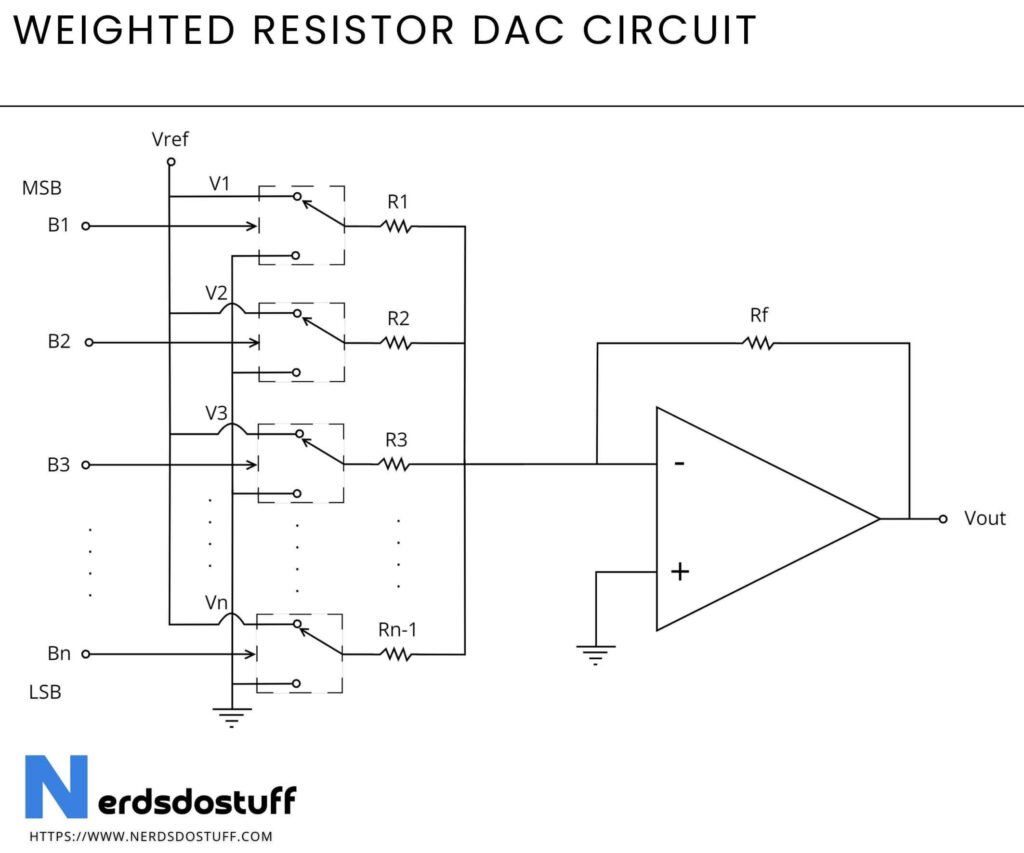What is Weighted Resistor DAC ?
A weighted resistor digital-to-analog converter (DAC) is a type of DAC that uses a network of resistors with values weighted according to the binary input to convert digital signals into corresponding analog voltages. This DAC configuration directly implements the digital-to-analog conversion by utilizing resistors whose values are inversely proportional to the binary weights of the input bits. For instance, if the binary input has bits 𝑏3,𝑏2,𝑏1,b3,b2,b1, and 𝑏0b0, then the resistor values would be chosen such that 𝑅,2𝑅,4𝑅,R,2R,4R, and 8𝑅8R respectively, where 𝑅R is a base resistor value. Each binary input bit controls a switch that connects either to a reference voltage or ground, thus contributing a corresponding weighted voltage to the output.
The operation of a weighted resistor DAC is straightforward: the binary input is applied to the DAC, and the weighted resistors produce currents or voltages proportional to each bit’s significance. These currents or voltages are then summed to generate the final analog output. For example, if a 4-bit binary input is used, the most significant bit (MSB) would contribute the largest voltage (or current) through its resistor, while the least significant bit (LSB) would contribute the smallest. The summation of these weighted voltages results in an analog output that is proportional to the binary input value. This type of DAC is relatively simple and provides a direct method for converting digital signals to analog form, but it can be limited by the precision and tolerance of the resistors, which can affect the overall accuracy and linearity of the conversion.
Weighted Resistor DAC Circuit

Working of Weighted Resistor DAC
A weighted resistor digital-to-analog converter (DAC) operates by using a network of resistors with values that correspond to the binary weights of the digital input signal. The digital input, represented as binary bits, is fed into the DAC, where each bit controls a switch connected to either a reference voltage (usually 𝑉𝑟𝑒𝑓Vref) or ground. The resistors are configured such that their values decrease in proportion to the significance of the corresponding binary bit. For instance, if the digital input is 4 bits (b3, b2, b1, b0), the resistors would be weighted as 𝑅,2𝑅,4𝑅,8𝑅R,2R,4R,8R, respectively. The switches are controlled in such a way that when a bit is high (1), the corresponding switch connects the resistor to the reference voltage, and when a bit is low (0), the switch connects the resistor to ground.
The operation of the weighted resistor DAC involves summing the currents or voltages through these resistors to produce a single analog output. Each resistor contributes a portion of the total output voltage based on the binary value it represents. For example, the MSB (b3) contributes the largest voltage through the smallest resistor (R), while the LSB (b0) contributes the smallest voltage through the largest resistor (8R). The voltages are then combined at a summing junction, typically at the input of an operational amplifier, which ensures the accurate summation of these voltages. The resulting output is a voltage that is proportional to the binary input, creating a precise analog representation of the digital signal.
Applications of Weighted Resistor DAC
- Volume Control in Audio Devices:
- Resistor-weighted DACs can adjust the volume in audio equipment, such as amplifiers and radios, by converting digital volume settings to precise analog signals.
- Analog Signal Generation:
- These DACs are used in function generators to create specific analog waveforms (like sine, square, and triangle waves) from digital signals for testing and measurement purposes.
- Digital Panel Meters:
- In digital panel meters, resistor-weighted DACs convert digital readings (like voltage or current measurements) into analog signals for display on an analog meter.
- Light Dimmers:
- Resistor-weighted DACs can convert digital brightness levels into analog signals to smoothly control the intensity of lighting systems.




